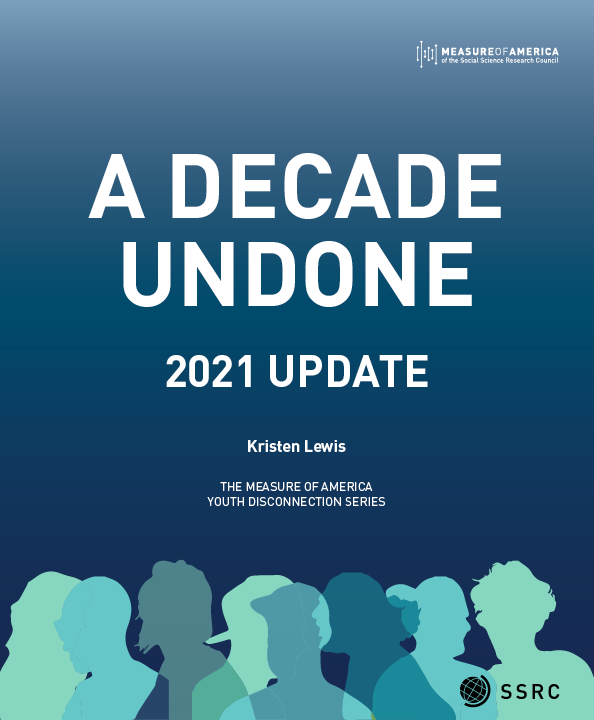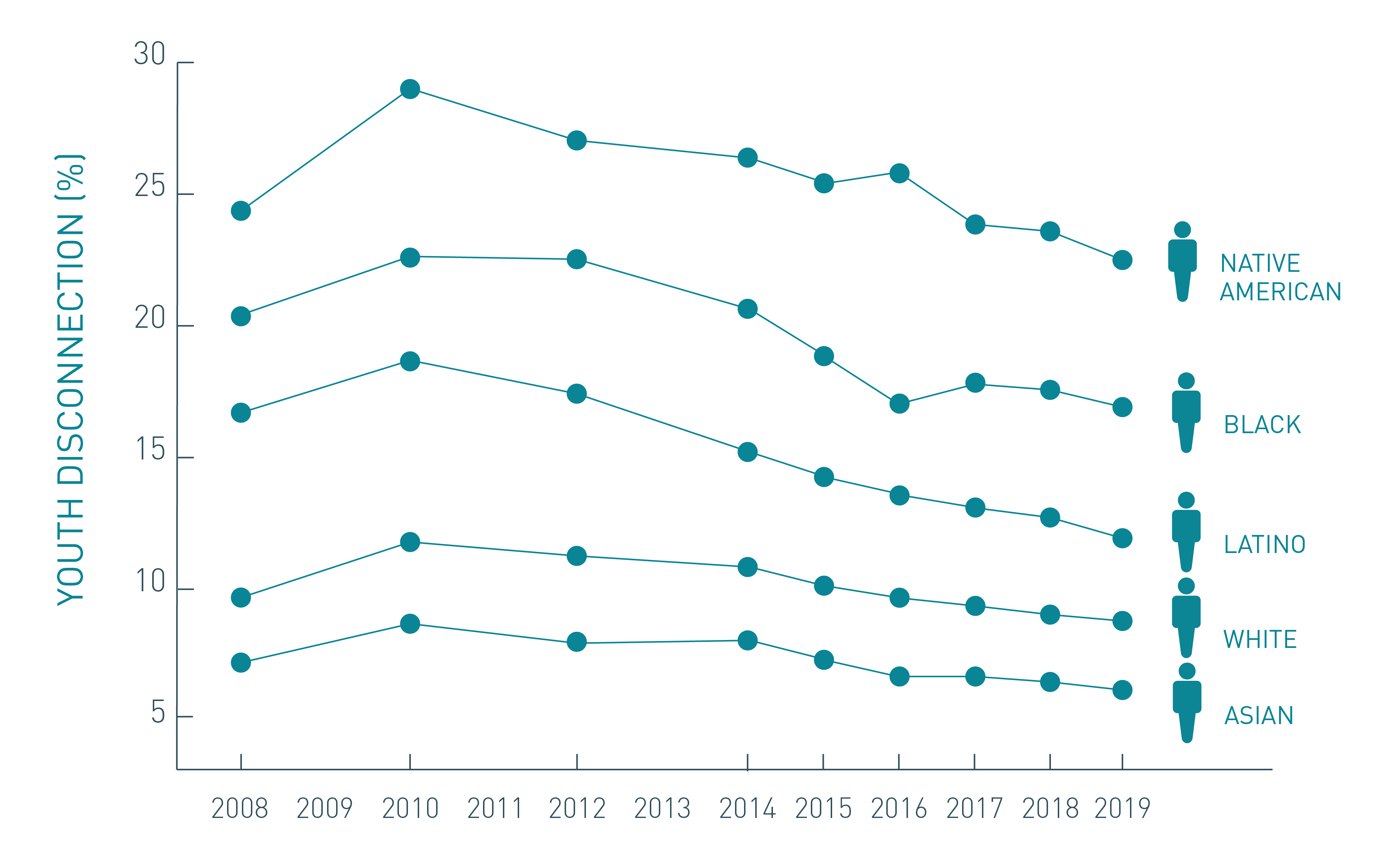A Decade Undone: 2021 Update
To see the most recent data, check out our interactive tool on youth disconnection.
LAUNCHED JULY 29, 2021
FULL REPORT | INTERACTIVE TOOL | MEDIA RELEASE
 A Decade Undone: 2021 Update, a follow-up to last year’s A Decade Undone: Youth Disconnection in the Age of Coronavirus, presents 2019 youth disconnection rates for the United States as a whole as well as by gender, race and ethnicity, region, state, metro area, county, congressional district, and public use microdata area (PUMA). These pre-coronavirus numbers create a map of vulnerability; they highlight where disconnection rates were already highest and therefore where the situation today is most precarious.
A Decade Undone: 2021 Update, a follow-up to last year’s A Decade Undone: Youth Disconnection in the Age of Coronavirus, presents 2019 youth disconnection rates for the United States as a whole as well as by gender, race and ethnicity, region, state, metro area, county, congressional district, and public use microdata area (PUMA). These pre-coronavirus numbers create a map of vulnerability; they highlight where disconnection rates were already highest and therefore where the situation today is most precarious.
The number of teens and young adults disconnected from both work and school in the United States fell for the ninth year in a row, from a recession-fueled high of 14.7 percent in 2010 to 10.7 percent in 2019. The Covid-19 pandemic has caused youth disconnection rates to spike dramatically. We estimate, based on currently available youth unemployment data from the Bureau for Labor Statistics, enrollment and employment data from the Census Current Population Survey, and school closure information, that in May 2020 as many as nine million young people were out of school and out of work, more than twice as many as in 2019. Given the decline in youth unemployment in the second half of 2020, we anticipate that the number for 2020 as a whole will be closer to six million—considerably higher than in the years after the Great Recession. With students physically disconnected from schools and unemployment the highest it’s been since the Great Depression, young people with the fewest resources will be left even further behind their peers and face the highest barriers to reconnection. While it is clear that young people of all stripes will suffer, low-income people of color will be the hardest hit.
In the conclusion to this report, Measure of America identifies thirty “post-pandemic priority counties” where the combination of already-high youth disconnection rates (24 percent and up) and lengthy stretches of virtual-learning education during the 2020–2021 academic year has created an educational emergency. In these counties with high rates of disconnection and school closures, already- and newly-disconnected youth urgently need assistance to close preexisting educational gaps, regain the ground they lost in 2020, reconnect to the education system, and receive the help they need to gain a foothold in the labor market.
KEY FINDINGS
- Nationally: The 2019 youth disconnection rate is 10.7 percent, or one in nine young people, down from 11.2 percent in 2018. The country’s disconnected youth are nearly twice as likely to live in poverty, more than three times as likely to have a disability, more than twice as likely to lack health insurance, and more than twenty times more likely to be institutionalized compared to connected youth. Disconnected youth 21-24 years old are less than half as likely to have a bachelor’s degree as their connected counterparts. Disconnected young women are over four times as likely to be mothers as their connected peers.

- Race and ethnicity: Native American youth had the highest disconnection rate (22.1 percent) of any major racial or ethnic group, followed by Black (16.7 percent), Latino (12.1 percent), white (8.8 percent), and Asian (5.7 percent) young people. Across all these groups, youth disconnection fell from 2018 to 2019.
- Gender: Women had a lower youth disconnection rate (10.3 percent) than men (11.0 percent); however, this gap varied by race and ethnicity. The largest racial gender gap existed between Black young women (13.7 percent) and Black young men (19.5 percent). Native American men’s youth disconnection rate of 23.3 percent was the highest for any race/gender combination.
- Public use microdata areas (PUMAs): PUMAs are areas defined by the US Census Bureau; they have populations of at least 100,000 people. To create these geographies, urban counties are split into many PUMAs (Los Angeles has 69, for example) and sparsely populated rural counties are joined together. The result is places with similarly-sized population groups that allow for apples-to-apples comparisons. The ten best-performing PUMAs can all be found in affluent sections of large cities or in well-to-do suburbs of major metro areas, and all have youth disconnection rates below 3 percent. The ten PUMAs facing the greatest challenges have youth disconnection rates that range from 28.9 percent to 35.0 percent. Two types of communities are found in this group: low-income, majority-minority neighborhoods in large metro areas, and isolated rural areas characterized by long-term, deep poverty.
- States: North Dakota has the lowest youth disconnection rate of any state (6.6 percent) and Alaska has the highest (18.7 percent). Washington D.C. experienced the largest increase in the share of disconnected young people, from 10.7 percent in 2018 to 15.6 percent in 2019. Idaho saw the largest drop in disconnection from 13.1 percent in 2018 to 8.6 percent in 2019, a decrease of 34 percent.
- Metro areas: Boston-Cambridge-Newton, MA-NH (6.0 percent) boasts the lowest disconnection rate of any metro area in the country. The highest rate of disconnection can be found in Augusta-Richmond County, GA-SC (17.9 percent).
- Counties: Rural counties have by far the highest average rate of youth disconnection, 17.3 percent; suburban counties have the lowest, 9.9 percent. County youth disconnection rates have the greatest range of any unit of geography. Virginia’s Harrisonburg City, a small city, has the lowest rate of youth disconnection in the country (2.2 percent), while the East Carroll Parish in Louisiana has the highest youth disconnection rate (81.0 percent).
- Congressional Districts: Colorado District 2, which includes suburbs north and west of Denver, has the lowest rate (3.8 percent). The congressional district with the highest rate of youth disconnection is District 1 in Nevada (20.7 percent), which includes Las Vegas and surrounding towns.